Darwin, Charles
| Charles Robert Darwin |
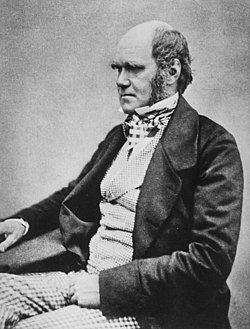
Charles Robert Darwin, aged 45 in 1854, by then working towards publication of On the Origin of Species.
|
| Born |
12 February 1809(1809-02-12)
Mount House, Shrewsbury, Shropshire, England |
| Died |
19 April 1882(1882-04-19) (aged 73)
Down House, Downe, Kent, England |
| Residence |
England |
| Citizenship |
British |
| Nationality |
British |
| Fields |
Naturalist |
| Institutions |
Geological Society of London |
| Alma mater |
University of Edinburgh
University of Cambridge |
| Academic advisors |
John Stevens Henslow
Adam Sedgwick |
| Known for |
The Voyage of the Beagle
On The Origin of Species
Natural selection |
| Influences |
Alexander von Humboldt
John Herschel
Charles Lyell |
| Influenced |
Joseph Dalton Hooker
Thomas Henry Huxley
George John Romanes
Ernst Haeckel |
| Notable awards |
Royal Medal (1853)
Wollaston Medal (1859)
Copley Medal (1864) |
Signature
 |
Charles Robert Darwin FRS (12 February 1809 – 19 April 1882) was an English naturalist.[I] He established that all species of life have descended over time from common ancestry, and proposed the scientific theory that this branching pattern of evolution resulted from a process that he called natural selection.
He published his theory with compelling evidence for evolution in his 1859 book On the Origin of Species.[1][2] The scientific community and much of the general public came to accept evolution as a fact in his lifetime.[3] However, it was not until the emergence of the modern evolutionary synthesis from the 1930s to the 1950s that a broad consensus developed that natural selection was the basic mechanism of evolution.[4] In modified form, Darwin's scientific discovery is the unifying theory of the life sciences, explaining the diversity of life.[5][6]
Darwin's early interest in nature led him to neglect his medical education at the University of Edinburgh; instead, he helped to investigate marine invertebrates. Studies at the University of Cambridge encouraged his passion for natural science.[7] His five-year voyage on HMS Beagle established him as an eminent geologist whose observations and theories supported Charles Lyell's uniformitarian ideas, and publication of his journal of the voyage made him famous as a popular author.[8]
Puzzled by the geographical distribution of wildlife and fossils he collected on the voyage, Darwin investigated the transmutation of species and conceived his theory of natural selection in 1838.[9] Although he discussed his ideas with several naturalists, he needed time for extensive research and his geological work had priority.[10] He was writing up his theory in 1858 when Alfred Russel Wallace sent him an essay which described the same idea, prompting immediate joint publication of both of their theories.[11] Darwin's work established evolutionary descent with modification as the dominant scientific explanation of diversification in nature.[3] In 1871, he examined human evolution and sexual selection in The Descent of Man, and Selection in Relation to Sex, followed by The Expression of the Emotions in Man and Animals. His research on plants was published in a series of books, and in his final book, he examined earthworms and their effect on soil.[12]
In recognition of Darwin's pre-eminence as a scientist, he was one of only five nineteenth-century non-royal personages from the United Kingdom to be honoured by a state funeral,[13] and was buried in Westminster Abbey, close to John Herschel and Isaac Newton.[14]
Life of Darwin
Childhood and education
See also: Charles Darwin's education and Darwin-Wedgwood family
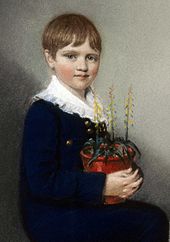
The seven-year-old Charles Darwin in 1816.
Charles Robert Darwin was born in Shrewsbury, Shropshire, England on 12 February 1809 at his family home, the Mount.[15] He was the fifth of six children of wealthy society doctor and financier Robert Darwin, and Susannah Darwin (née Wedgwood). He was the grandson of Erasmus Darwin on his father's side, and of Josiah Wedgwood on his mother's side. Both families were largely Unitarian, though the Wedgwoods were adopting Anglicanism. Robert Darwin, himself quietly a freethinker, had baby Charles baptised in the Anglican Church, but Charles and his siblings attended the Unitarian chapel with their mother. The eight-year-old Charles already had a taste for natural history and collecting when he joined the day school run by its preacher in 1817. That July, his mother died. From September 1818, he joined his older brother Erasmus attending the nearby Anglican Shrewsbury School as a boarder.[16]
Darwin spent the summer of 1825 as an apprentice doctor, helping his father treat the poor of Shropshire, before going to the University of Edinburgh Medical School with his brother Erasmus in October 1825. He found lectures dull and surgery distressing, so neglected his studies. He learned taxidermy from John Edmonstone, a freed black slave who had accompanied Charles Waterton in the South American rainforest, and often sat with this "very pleasant and intelligent man".[17]
In Darwin's second year he joined the Plinian Society, a student natural history group whose debates strayed into radical materialism. He assisted Robert Edmund Grant's investigations of the anatomy and life cycle of marine invertebrates in the Firth of Forth, and on 27 March 1827 presented at the Plinian his own discovery that black spores found in oyster shells were the eggs of a skate leech. One day, Grant praised Lamarck's evolutionary ideas. Darwin was astonished, but had recently read the similar ideas of his grandfather Erasmus and remained indifferent.[18] Darwin was rather bored by Robert Jameson's natural history course which covered geology including the debate between Neptunism and Plutonism. He learned classification of plants, and assisted with work on the collections of the University Museum, one of the largest museums in Europe at the time.[19]
This neglect of medical studies annoyed his father, who shrewdly sent him to Christ's College, Cambridge, for a Bachelor of Arts degree as the first step towards becoming an Anglican parson. As Darwin was unqualified for the Tripos, he joined the ordinary degree course in January 1828.[20] He preferred riding and shooting to studying. His cousin William Darwin Fox introduced him to the popular craze for beetle collecting which Darwin pursued zealously, getting some of his finds published in Stevens' Illustrations of British entomology. He became a close friend and follower of botany professor John Stevens Henslow and met other leading naturalists who saw scientific work as religious natural theology, becoming known to these dons as "the man who walks with Henslow". When his own exams drew near, Darwin focused on his studies and was delighted by the language and logic of William Paley's Evidences of Christianity.[21] In his final examination in January 1831 Darwin did well, coming tenth out of 178 candidates for the ordinary degree.[22]
Darwin had to stay at Cambridge until June. He studied Paley's Natural Theology which made an argument for divine design in nature, explaining adaptation as God acting through laws of nature.[23] He read John Herschel's new book which described the highest aim of natural philosophy as understanding such laws through inductive reasoning based on observation, and Alexander von Humboldt's Personal Narrative of scientific travels. Inspired with "a burning zeal" to contribute, Darwin planned to visit Tenerife with some classmates after graduation to study natural history in the tropics. In preparation, he joined Adam Sedgwick's geology course, then went with him in the summer for a fortnight to map strata in Wales.[24] After a week with student friends at Barmouth, he returned home to find a letter from Henslow proposing Darwin as a suitable (if unfinished) gentleman naturalist for a self-funded place with captain Robert FitzRoy, more as a companion than a mere collector, on HMS Beagle which was to leave in four weeks on an expedition to chart the coastline of South America.[25] His father objected to the planned two-year voyage, regarding it as a waste of time, but was persuaded by his brother-in-law, Josiah Wedgwood, to agree to his son's participation.[26]
Voyage of the Beagle
For more details on this topic, see Second voyage of HMS Beagle.
Beginning on the 27th of December, 1831, the voyage lasted almost five years and, as FitzRoy had intended, Darwin spent most of that time on land investigating geology and making natural history collections, while the Beagle surveyed and charted coasts.[3][27] He kept careful notes of his observations and theoretical speculations, and at intervals during the voyage his specimens were sent to Cambridge together with letters including a copy of his journal for his family.[28] He had some expertise in geology, beetle collecting and dissecting marine invertebrates, but in all other areas was a novice and ably collected specimens for expert appraisal.[29] Despite repeatedly suffering badly from seasickness while at sea, most of his zoology notes are about marine invertebrates, starting with plankton collected in a calm spell.[27][30]
On their first stop ashore at St. Jago, Darwin found that a white band high in the volcanic rock cliffs included seashells. FitzRoy had given him the first volume of Charles Lyell's Principles of Geology which set out uniformitarian concepts of land slowly rising or falling over immense periods,[II] and Darwin saw things Lyell's way, theorising and thinking of writing a book on geology.[31] In Brazil, Darwin was delighted by the tropical forest,[32] but detested the sight of slavery.[33]
At Punta Alta in Patagonia he made a major find of fossil bones of huge extinct mammals in cliffs beside modern seashells, indicating recent extinction with no signs of change in climate or catastrophe. He identified the little known Megatherium by a tooth and its association with bony armour which had at first seemed to him like a giant version of the armour on local armadillos. The finds brought great interest when they reached England.[34][35] On rides with gauchos into the interior to explore geology and collect more fossils he gained social, political and anthropological insights into both native and colonial people at a time of revolution, and learnt that two types of rhea had separate but overlapping territories.[36][37] Further south he saw stepped plains of shingle and seashells as raised beaches showing a series of elevations. He read Lyell's second volume and accepted its view of "centres of creation" of species, but his discoveries and theorising challenged Lyell's ideas of smooth continuity and of extinction of species.[38][39]
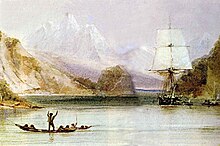
As HMS
Beagle surveyed the coasts of South America, Darwin theorised about geology and extinction of giant mammals.
Three Fuegians on board, who had been seized during the first Beagle voyage and had spent a year in England, were taken back to Tierra del Fuego as missionaries. Darwin found them friendly and civilised, yet their relatives seemed "miserable, degraded savages", as different as wild from domesticated animals.[40] To Darwin the difference showed cultural advances, not racial inferiority. Unlike his scientist friends, he now thought there was no unbridgeable gap between humans and animals.[41] A year on, the mission had been abandoned. The Fuegian they had named Jemmy Button lived like the other natives, had a wife, and had no wish to return to England.[42]
Darwin experienced an earthquake in Chile and saw signs that the land had just been raised, including mussel-beds stranded above high tide. High in the Andes he saw seashells, and several fossil trees that had grown on a sand beach. He theorised that as the land rose, oceanic islands sank, and coral reefs round them grew to form atolls.[43][44]
On the geologically new Galápagos Islands Darwin looked for evidence attaching wildlife to an older "centre of creation", and found mockingbirds allied to those in Chile but differing from island to island. He heard that slight variations in the shape of tortoise shells showed which island they came from, but failed to collect them, even after eating tortoises taken on board as food.[45][46] In Australia, the marsupial rat-kangaroo and the platypus seemed so unusual that Darwin thought it was almost as though two distinct Creators had been at work.[47] He found the Aborigines "good-humoured & pleasant", and noted their depletion by European settlement.[48]
The Beagle investigated how the atolls of the Cocos (Keeling) Islands had formed, and the survey supported Darwin's theorising.[44] FitzRoy began writing the official Narrative of the Beagle voyages, and after reading Darwin's diary he proposed incorporating it into the account.[49] Darwin's Journal was eventually rewritten as a separate third volume, on natural history.[50]
In Cape Town Darwin and FitzRoy met John Herschel, who had recently written to Lyell praising his uniformitarianism as opening bold speculation on "that mystery of mysteries, the replacement of extinct species by others" as "a natural in contradistinction to a miraculous process".[51] When organising his notes as the ship sailed home, Darwin wrote that if his growing suspicions about the mockingbirds, the tortoises and the Falkland Islands Fox were correct, "such facts undermine the stability of Species", then cautiously added "would" before "undermine".[52] He later wrote that such facts "seemed to me to throw some light on the origin of species".[53]
Inception of Darwin's evolutionary theory
For more details on this topic, see Inception of Darwin's theory.
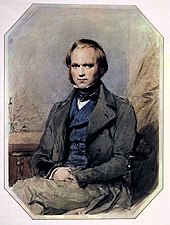
While still a young man, Charles Darwin joined the scientific elite
When the Beagle reached Falmouth, Cornwall, on 2 October 1836, Darwin was already a celebrity in scientific circles as in December 1835 Henslow had fostered his former pupil's reputation by giving selected naturalists a pamphlet of Darwin's geological letters.[54] Darwin visited his home in Shrewsbury and saw relatives, then hurried to Cambridge to see Henslow, who advised on finding naturalists available to catalogue the collections and agreed to take on the botanical specimens. Darwin's father organised investments, enabling his son to be a self-funded gentleman scientist, and an excited Darwin went round the London institutions being fêted and seeking experts to describe the collections. Zoologists had a huge backlog of work, and there was a danger of specimens just being left in storage.[55]
Charles Lyell eagerly met Darwin for the first time on 29 October and soon introduced him to the up-and-coming anatomist Richard Owen, who had the facilities of the Royal College of Surgeons to work on the fossil bones collected by Darwin. Owen's surprising results included other gigantic extinct ground sloths as well as the Megatherium, a near complete skeleton of the unknown Scelidotherium and a hippopotamus-sized rodent-like skull named Toxodon resembling a giant capybara. The armour fragments were actually from Glyptodon, a huge armadillo-like creature as Darwin had initially thought.[56][35] These extinct creatures were related to living species in South America.[57]
In mid-December Darwin took lodgings in Cambridge to organise work on his collections and rewrite his Journal.[58] He wrote his first paper, showing that the South American landmass was slowly rising, and with Lyell's enthusiastic backing read it to the Geological Society of London on 4 January 1837. On the same day, he presented his mammal and bird specimens to the Zoological Society. The ornithologist John Gould soon announced that the Galapagos birds that Darwin had thought a mixture of blackbirds, "gros-beaks" and finches, were, in fact, twelve separate species of finches. On 17 February Darwin was elected to the Council of the Geological Society, and Lyell's presidential address presented Owen's findings on Darwin's fossils, stressing geographical continuity of species as supporting his uniformitarian ideas.[59]
Early in March, Darwin moved to London to be near this work, joining Lyell's social circle of scientists and experts such as Charles Babbage,[60] who described God as a programmer of laws. John Herschel's letter on the "mystery of mysteries" of new species was widely discussed, with explanations sought in laws of nature, not ad hoc miracles. Darwin stayed with his freethinking brother Erasmus, part of this Whig circle and close friend of writer Harriet Martineau who promoted Malthusianism underlying the controversial Whig Poor Law reforms to stop welfare from causing overpopulation and more poverty. As a Unitarian she welcomed the radical implications of transmutation of species, promoted by Grant and younger surgeons influenced by Geoffroy, but anathema to Anglicans defending social order.[51][61]
Gould met Darwin and told him that the Galápagos mockingbirds from different islands were separate species, not just varieties, and what Darwin had thought was a "wren" was also in the finch group. Darwin had not labelled the finches by island, but from the notes of others on the Beagle, including FitzRoy, he allocated species to islands.[62] The two rheas were also distinct species, and on 14 March Darwin announced how their distribution changed going southwards.[63]
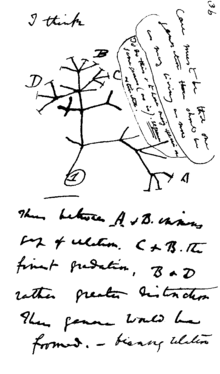
In mid-July 1837 Darwin started his "B" notebook on
Transmutation of Species, and on page 36 wrote "I think" above his first evolutionary tree.
By mid-March, Darwin was speculating in his Red Notebook on the possibility that "one species does change into another" to explain the geographical distribution of living species such as the rheas, and extinct ones such as the strange Macrauchenia which resembled a giant guanaco. His thoughts on lifespan, asexual reproduction and sexual reproduction developed in his "B" notebook around mid-July on to variation in offspring "to adapt & alter the race to changing world" explaining the Galápagos tortoises, mockingbirds and rheas. He sketched branching descent, then a genealogical branching of a single evolutionary tree, in which "It is absurd to talk of one animal being higher than another", discarding Lamarck's independent lineages progressing to higher forms.[64]
Overwork, illness, and marriage
See also: Charles Darwin's health
While developing this intensive study of transmutation, Darwin became mired in more work. Still rewriting his Journal, he took on editing and publishing the expert reports on his collections, and with Henslow's help obtained a Treasury grant of £1,000 to sponsor this multi-volume Zoology of the Voyage of H.M.S. Beagle, a sum equivalent to about £75,000 in 2008.[65] He stretched the funding to include his planned books on geology, and agreed unrealistic dates with the publisher.[66] As the Victorian era began, Darwin pressed on with writing his Journal, and in August 1837 began correcting printer's proofs.[67]
Darwin's health suffered from the pressure. On 20 September he had "an uncomfortable palpitation of the heart", so his doctors urged him to "knock off all work" and live in the country for a few weeks. After visiting Shrewsbury he joined his Wedgwood relatives at Maer Hall, Staffordshire, but found them too eager for tales of his travels to give him much rest. His charming, intelligent, and cultured cousin Emma Wedgwood, nine months older than Darwin, was nursing his invalid aunt. His uncle Jos pointed out an area of ground where cinders had disappeared under loam and suggested that this might have been the work of earthworms, inspiring "a new & important theory" on their role in soil formation which Darwin presented at the Geological Society on 1 November.[68]
William Whewell pushed Darwin to take on the duties of Secretary of the Geological Society. After initially declining the work, he accepted the post in March 1838.[69] Despite the grind of writing and editing the Beagle reports, Darwin made remarkable progress on transmutation, taking every opportunity to question expert naturalists and, unconventionally, people with practical experience such as farmers and pigeon fanciers.[3][70] Over time his research drew on information from his relatives and children, the family butler, neighbours, colonists and former shipmates.[71] He included mankind in his speculations from the outset, and on seeing an orangutan in the zoo on 28 March 1838 noted its child-like behaviour.[72]
The strain took a toll, and by June he was being laid up for days on end with stomach problems, headaches and heart symptoms. For the rest of his life, he was repeatedly incapacitated with episodes of stomach pains, vomiting, severe boils, palpitations, trembling and other symptoms, particularly during times of stress such as attending meetings or making social visits. The cause of Darwin's illness remained unknown, and attempts at treatment had little success.[73]
On 23 June he took a break and went "geologising" in Scotland. He visited Glen Roy in glorious weather to see the parallel "roads" cut into the hillsides at three heights. He later published his view that these were marine raised beaches, but then had to accept that they were shorelines of a proglacial lake.[74]
Fully recuperated, he returned to Shrewsbury in July. Used to jotting down daily notes on animal breeding, he scrawled rambling thoughts about career and prospects on two scraps of paper, one with columns headed "Marry" and "Not Marry". Advantages included "constant companion and a friend in old age ... better than a dog anyhow", against points such as "less money for books" and "terrible loss of time."[75] Having decided in favour, he discussed it with his father, then went to visit Emma on 29 July. He did not get around to proposing, but against his father's advice he mentioned his ideas on transmutation.[76]
Continuing his research in London, Darwin's wide reading now included the sixth edition of Malthus's An Essay on the Principle of Population
In October 1838, that is, fifteen months after I had begun my systematic enquiry, I happened to read for amusement Malthus on Population, and being well prepared to appreciate the struggle for existence which everywhere goes on from long-continued observation of the habits of animals and plants, it at once struck me that under these circumstances favourable variations would tend to be preserved, and unfavourable ones to be destroyed. The result of this would be the formation of new species. Here, then, I had at last got a theory by which to work...[77]
Malthus asserted that unless human population is kept in check, it increases in a geometrical progression and soon exceeds food supply in what is known as a Malthusian catastrophe.[3] Darwin was well prepared to see at once that this also applied to de Candolle's "warring of the species" of plants and the struggle for existence among wildlife, explaining how numbers of a species kept roughly stable. As species always breed beyond available resources, favourable variations would make organisms better at surviving and passing the variations on to their offspring, while unfavourable variations would be lost. This would result in the formation of new species.[3][78] On 28 September 1838 he noted this insight, describing it as a kind of wedging, forcing adapted structures into gaps in the economy of nature as weaker structures were thrust out.[3] By mid December he saw a similarity between farmers picking the best breeding stock and a Malthusian Nature selecting from chance variants so that "every part of newly acquired structure is fully practical and perfected",[79] thinking this comparison "a beautiful part of my theory".[80]

Darwin chose to marry his cousin, Emma Wedgwood.
On 11 November, he returned to Maer and proposed to Emma, once more telling her his ideas. She accepted, then in exchanges of loving letters she showed how she valued his openness in sharing their differences, also expressing her strong Unitarian beliefs and concerns that his honest doubts might separate them in the afterlife.Books By This Author